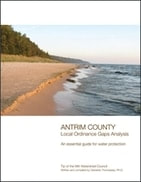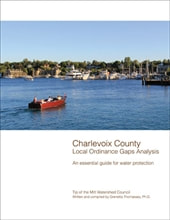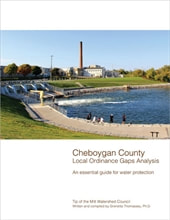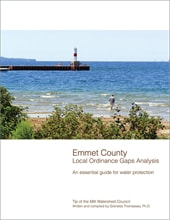Local Policy Initiatives
Aquavist Network
The Aquavists are an informed and empowered activist community dedicated to protecting Northern Michigan's waters. The Aquavist Network forms a unique rapid response team to act as a voice for the waters in Antrim, Charlevoix, Cheboygan, and Emmet Counties. Aquavists provide support to our neighbors using our centrally-located base camp in cyberspace. It is designed to inform and empower citizens and make it easier to solve problems and share resources.
The Aquavists are an informed and empowered activist community dedicated to protecting Northern Michigan's waters. The Aquavist Network forms a unique rapid response team to act as a voice for the waters in Antrim, Charlevoix, Cheboygan, and Emmet Counties. Aquavists provide support to our neighbors using our centrally-located base camp in cyberspace. It is designed to inform and empower citizens and make it easier to solve problems and share resources.
Bay Harbor CKD Contamination and Remediation
Over 80 years of cement manufacturing left behind an estimated 2.5 million cubic yards of cement kiln dust (CKD) at what is now known as Bay Harbor Properties and East Park. When water comes into contact with the CKD, it can leach substances from the CKD and contaminate adjacent waters. This leachate can have high pH and can contain heavy metals such as mercury, arsenic, and lead, which pose adverse impacts to water quality, fish and other aquatic life, and, potentially, human health with direct contact. Tip of the Mitt Watershed Council has been actively involved with the CKD contamination and cleanup efforts along Little Traverse Bay for over 25 years working with the involved parties to ensure the cleanup is done properly and thoroughly to protect public health and environmental quality.
Click here to read more about this issue.
Over 80 years of cement manufacturing left behind an estimated 2.5 million cubic yards of cement kiln dust (CKD) at what is now known as Bay Harbor Properties and East Park. When water comes into contact with the CKD, it can leach substances from the CKD and contaminate adjacent waters. This leachate can have high pH and can contain heavy metals such as mercury, arsenic, and lead, which pose adverse impacts to water quality, fish and other aquatic life, and, potentially, human health with direct contact. Tip of the Mitt Watershed Council has been actively involved with the CKD contamination and cleanup efforts along Little Traverse Bay for over 25 years working with the involved parties to ensure the cleanup is done properly and thoroughly to protect public health and environmental quality.
Click here to read more about this issue.
Emmet County Phragmites Control Project
An invasive type of the reed, Phragmites, has been found in our region, particularly along Great Lakes shorelines. Tip of the Mitt Watershed Council teamed up with the Emmet County Board of Commissioners and Emmet County Lakeshore Association to successfully control Phragmites on the shores of Lake Michigan. Over the years, treatment of growth stands has been conducted under a single permit obtained by Emmet County on behalf of its citizens. We continue our work to ensure that Phragmites is well understood, and that management options are clearly spelled out. Through collaboration, intensive surveys, and persistence, Tip of the Mitt Watershed Council is making great strides toward protecting our shorelines from the invasion of this nonnative species.
An invasive type of the reed, Phragmites, has been found in our region, particularly along Great Lakes shorelines. Tip of the Mitt Watershed Council teamed up with the Emmet County Board of Commissioners and Emmet County Lakeshore Association to successfully control Phragmites on the shores of Lake Michigan. Over the years, treatment of growth stands has been conducted under a single permit obtained by Emmet County on behalf of its citizens. We continue our work to ensure that Phragmites is well understood, and that management options are clearly spelled out. Through collaboration, intensive surveys, and persistence, Tip of the Mitt Watershed Council is making great strides toward protecting our shorelines from the invasion of this nonnative species.
Gaps Analysis
The Local Ordinance Gaps Analysis is a review of all the water-related ordinances in Tip of Mitt Watershed Council’s service area by county. The purpose is to evaluate existing local ordinances against what should be in place to best protect water resources, and offer recommendations and suggested actions to help local governments strengthen any areas that need improved. It covers ordinances at not only the county level, but also for cities, townships, and villages in the county.
The Local Ordinance Gaps Analysis is a review of all the water-related ordinances in Tip of Mitt Watershed Council’s service area by county. The purpose is to evaluate existing local ordinances against what should be in place to best protect water resources, and offer recommendations and suggested actions to help local governments strengthen any areas that need improved. It covers ordinances at not only the county level, but also for cities, townships, and villages in the county.
|
Prescription and Over-the-Counter Drug Drop-Off Program
The Prescription and Over-the-Counter Drug Drop-Off Program or POD Program is a multicounty-wide medication drug take back initiative to provide a convenient way for residents to properly dispose of prescription and over-the-counter medications. The POD Program includes community collection events in Antrim, Charlevoix, Cheboygan, and Emmet Counties. The POD Program also includes permanent collection drop boxes at law enforcement agencies located throughout Northern Michigan. Residents and visitors may safely dispose of prescription, over-the-counter pharmaceuticals, and personal care products for free. Controlled substances are accepted at the events and at all collection boxes. |
Septic System Policies
Most on-site septic systems in the State of Michigan are never inspected again once installed. Michigan is the only state in the nation without uniform standards for how on-site septic systems are sited, designed, built, installed, and maintained. Public health officials believe reported septic system failures represent only a fraction of the total number of failures statewide and many go undetected or remain unreported for years. In most counties in Michigan, after a system is built, the counties do not follow up to make sure those systems are functioning properly. Because this important follow-up is non-existent in most places, it creates a potential threat to public health and water resources. The Watershed Council, working with local partners, is examining septic system policies, identifying any problems, and examining potential ways to solve them.
Most on-site septic systems in the State of Michigan are never inspected again once installed. Michigan is the only state in the nation without uniform standards for how on-site septic systems are sited, designed, built, installed, and maintained. Public health officials believe reported septic system failures represent only a fraction of the total number of failures statewide and many go undetected or remain unreported for years. In most counties in Michigan, after a system is built, the counties do not follow up to make sure those systems are functioning properly. Because this important follow-up is non-existent in most places, it creates a potential threat to public health and water resources. The Watershed Council, working with local partners, is examining septic system policies, identifying any problems, and examining potential ways to solve them.








